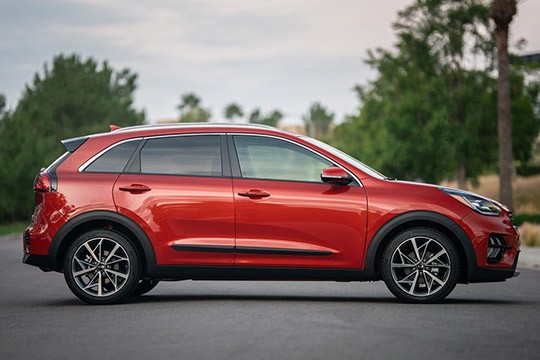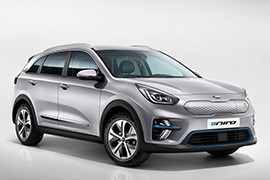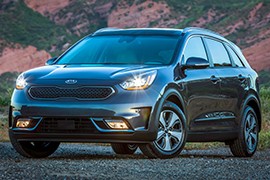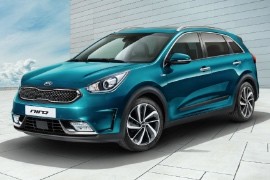KIA Niro Models/Series Timeline, Specifications & Photos
First production year: 2016
Engines: Gasoline, Electric, Hybrid, Hybrid gasoline
Body style: SUV (Sports Utility Vehicle)
Kia decided to gift the successful Niro Hybrid compact crossover with an early mid-cycle facelift in 2019, with the model receiving a host of several exterior and interior enhancements alongside improved technology features. Part of the extensive design refresh, the car now features new projector-type headlamps and fog lamps, a redesigned diamond-pattern grille and chevron-shaped LED daytime running lights on the front end.
At the rear there is a new fake skid plate that is wider and more pronounced for a bolder, more off-road-ready look and a new LED combination taillight design. On the inside the modifications are even more extensive, with the 7-inch instrument cluster having been redesigned alongside the standard 8-inch touchscreen display on the center console. A navigation system with a 10.25-inch screen is optional, as is a premium audio system from Harman Kardon. Sporty paddle shifters to give the driver more control are also optionally available. The so-called Kia Drive Wise Advanced Driver Assistance Systems have been updated to also include Lane Following and Lane Keeping Assist, while the headlights now have a High Beam Assist function. Powertrain and overall exterior and interior dimensions have remained completely unchanged from the non-facelift Niro Hybrid, and so have the performance and fuel economy figures.
When Kia introduced the Niro on the market in 2016, it built it on a platform ready to host either an internal combustion version, a hybrid, a PHEV, or a full-electric drivetrain.
After conquering customers with the fossil-fueled versions, the Korean automaker finally launched the electron-powered version in 2018, also known as the e-Niro. While it kept most advantages of its siblings, this one had the advantage of driving with no emissions on the tailpipe since it didn't feature one.
The exterior look was mostly the same as that of its siblings. Still, at the front, Kia mounted a panel instead of the main grille but left an air intake in the lower part of the bumper. The e-Niro also sported new LED daytime running lights shaped like arrows pointing toward the car's center. From its profile, the tall greenhouse fitted with generous windows matched the look of a regular crossover. In addition, the higher ground clearance than on a normal hatchback confirmed the car's status.
Inside, Kia offered the e-Niro with a rich standard package that included high-mounted power seats at the front and a split-folding bench seat in the back. The driver fronted a digital instrument panel installed inside the binnacle, while the infotainment screen integrated atop the center stack provided additional information about the car's and battery's status. Unlike the rest of the Niro's range, this electron-powered version didn't feature a gear stick. Drivers could select the driving programs via a rotary knob placed on the center console.
Kia offered the EV with a choice of two motors and two different battery packs. In its most advanced version, the e-Niro could cover a distance of up to 485 km (301 miles) between charges.
After introducing the Niro Hybrid in 2017, Kia stepped up the game and launched a plug-in hybrid version for its compact crossover in 2018.
Customers went from the horsepower war to the fuel-efficiency war in just a decade, and the Korean carmaker jumped from producing cheap vehicles to almost premium cars. While Kia didn't impress with high-performance sports cars, it tried to save some penguins with its hybrids and plug-in hybrid models such as the Niro.
On the outside, it was the same crossover vehicle as to the regular model. It was taller than a regular station wagon but not as tall as a minivan or SUV. The pinched "tiger-nose" grille imagined by Peter Schreyer as a brand image for Kia worked well on the Niro, especially since it was mixed with the angular-looking headlights that resembled a pair of tiger eyes. On the right-front fender, a lid covered the charging port, which was the main difference compared to its hybrid-only sibling. At the back, the carmaker concealed the tailpipe for the internal combustion engine behind the bumper.
Inside, the roomy cabin shared most parts with the regular Niro. Its blue accents around the air vents and the nice fits and finishes gave the impression of a pre-premium vehicle. It wasn't at Audi's standards, but it was above a cee'd. There was enough room for five adults inside and a generous trunk in the back. Yet, the storage volume decreased when compared to its siblings due to the larger battery.
Under the hood, Kia relied on the same naturally aspirated 1.6-liter engine helped by an electric motor. The total output was 141 hp, and the powerplant sent its torque to the front wheels via a six-speed automatic (dual-clutch) gearbox.
Is it an SUV, is it a car, it was hard to say at that time. The truth be told, the 2016 Kia Niro was a true crossover vehicle unveiled in February 2016 at the Chicago Auto Show.
The Kia Niro received the official Guinness World Records for the lowest fuel consumption in the world for a hybrid vehicle. The official figure was 76.551 mpg (3.07 l/100 km) and it was obtained in real traffic, from Los Angeles to New York on December 11, 2016, by Bob Winger – Wayne Gerdes after a 7 days trip.
The car's styling was made in Kia's design center in California by a team led by Peter Schreyer. They created a vehicle with a low roof-line and short overhangs, to maximize the wheelbase and thus offered more inside room. The drag-coefficient of the subcompact crossover SUV was just 0.29, an unusual figure for a car in that class.
Inside, the car featured an uncluttered instrument panel and clean, informative gauges. The big, 2700 mm (106.3”) wheelbase allowed a good interior space. Due to the elevated seating position, typical for a crossover, it allowed a bigger headroom and legroom.
The engine was a 1.6-liter turbocharged gasoline unit that ran in Atkinson Cycle technology it was aided by a 43 hp electric motor. The entire system was mated to a 6-speed dual-clutch automatic gearbox.



